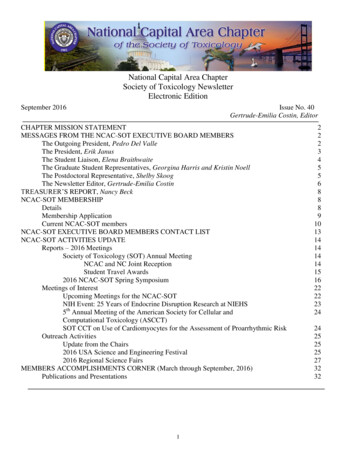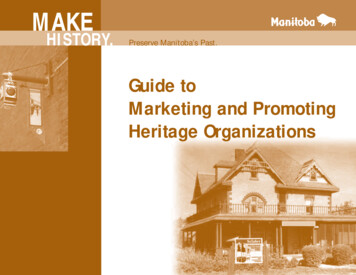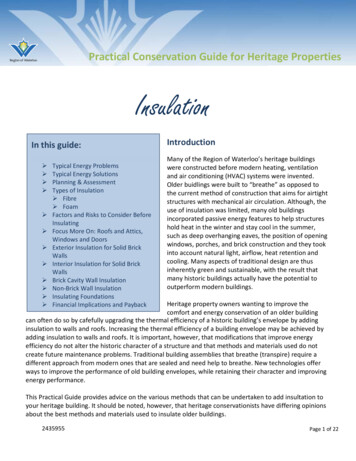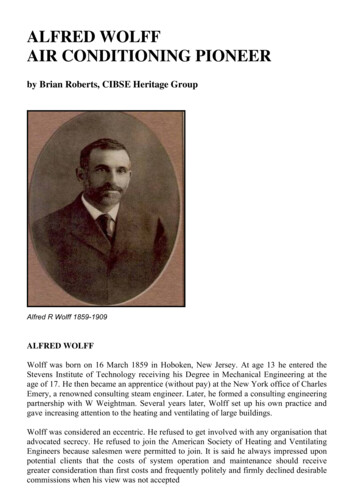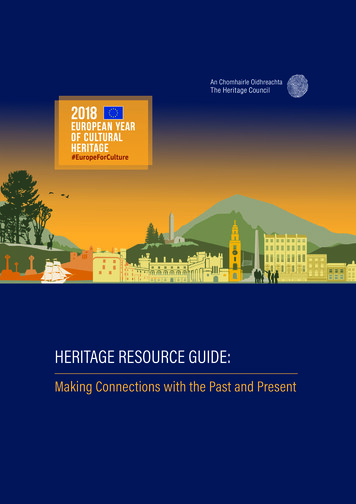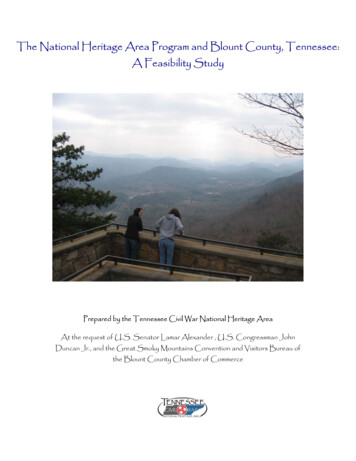
Transcription
The National Heritage Area Program and Blount County, Tennessee:Final Report, April 7, 2006A Feasibility StudyPrepared by the Tennessee Civil War National Heritage AreaAt the request of U.S. Senator Lamar Alexander , U.S. Congressman JohnDuncan Jr., and the Great Smoky Mountains Convention and Visitors Bureau ofthe Blount County Chamber of Commerce
TABLE OF CONTENTSPROJECT BACKGROUND. 3INTRODUCTION TO BLOUNT COUNTY . 4RESOURCE SURVEY. 6GREAT SMOKY MOUNTAINS NATIONAL PARK AND SURROUNDING AREAS. 6FOOTHILLS PARKWAY . 8MARYVILLE COLLEGE . 12TOWNSEND ARCHAEOLOGICAL PROJECT . 13SAM HOUSTON SCHOOLHOUSE . 14ADDITIONAL IMPORTANT HISTORICAL AND NATURAL RESOURCES . 16National Register Listings in Blount County. 16Tennessee Century Farms in Blount County . 26Rural African American Churches in Blount County . 29CULTURAL AND HISTORICAL INSTITUTIONS, MUSEUMS . 30LOCAL HERITAGE TRAILS . 31ARTS AND CRAFTS . 33ENVIRONMENTAL AWARENESS AND CONSERVATION. 33CULTURAL TRADITIONS AND FOLK WAYS. 36CONSERVATION . 38N ATIONAL HISTORY AND EFFORTS FOR CONSERVATION . 42PUBLIC SUPPORT . 44MEETING 1 . 44MEETING 2 . 46MEETING 3 . 47PROJECT BOUNDARIES . 49CONCEPTUAL FINANCIAL PLAN . 50PROJECT ADMINISTRATION AT THE LOCAL LEVEL . 512
Project BackgroundIn 2004-2005 residents of Maryville, the county seat of Blount County, participated in awide ranging community forum for the city’s and county’s future Urban Growth Strategyas part of a local response to the more regional planning process known as “Nine-County,One Vision.” The consulting firm of Hunter Interests carried out the community forumsand prepared the final draft plan. Its first recommended action called for the city andcounty to “expand the green infrastructure system to preserve existing opening space, andadd elements that will benefit water quality, soil conservation, and the overall quality oflife.” The consultants also emphasized at several places the option of the communitycreating a federally-designated National Heritage Area.The Urban Growth Strategy calling for partnerships to enhance the community throughquality growth was seconded by the May 2005 release of a Sustainable Tourism StrategicPlan, prepared by the Great Smoky Mountains Convention and Visitors Bureau and theBlount County Chamber of Commerce. This strategic plan set the goal of creating“high-quality, geo-tourism experiences tied to our heritage and culture.” It also called forthe development of “a consistent & authentic/accurate destination story” and to “work toensure a quality trip experience on the way to the destination.”Shortly thereafter, local officials began to talk with the Tennessee Civil War NationalHeritage Area (Tennessee Civil War NHA) on how it could help the community. TheTennessee Civil War NHA covers the entire state of Tennessee and is a recognizednational leader in best practices for heritage area development. It is also the headquartersfor the Heritage Development Institute, a program of the Alliance of National HeritageAreas. The Tennessee Civil War NHA is administered through the MTSU Center forHistoric Preservation (Center), one of the state’s 16 Centers of Excellence, a programestablished by Governor Lamar Alexander and the Tennessee General Assembly in 1984.On June 30, 2005, Dr. Van West, Center Director, and Laura Holder, Manager of theTennessee Civil War NHA, met with community representatives from Blount County atthe request of Darrell Akins and Herb Handly, as well as Bill Sullivan from SenatorAlexander’s D.C. office, to provide an overview for creating a National Heritage Area.As a result of this meeting, community representatives requested a proposal from theTennessee Civil War NHA for the creation of a feasibility study to evaluate BlountCounty’s potential for heritage area designation.The feasibility study is a joint venture between the Smoky Mountain Convention andVisitors Bureau, Blount County partners and the Tennessee Civil War NHA to documentand evaluate Blount County’s nationally significant historic, natural and culturalresources within the context of public, financial and managerial support at the local andstate levels for a National Heritage Area or similar federal program option.Blount County, with its wealth of rural landscapes, historic resources, and proximity tothe Great Smoky Mountains National Park, has been one of the fastest growing countiesin Tennessee during the last ten years. The goal of the feasibility study is to provideoptions for Blount County that will enable the region to sustain economic development3
while conserving the cultural heritage, rural character, natural resources and livinglandscapes that make the area unique.Preliminary discussions with community stakeholders, residents and elected officialshave demonstrated support across multi-disciplinary fields, including tourism, economicdevelopment, planning, preservation, and recreation, as well as residents and propertyowners. Interested partners to date include the Smoky Mountains Convention andVisitors Bureau, the Hunter Interests Group, the Townsend Planning Commission, theFoothills Conservancy, Tuckaleechee Cove, the Great Smoky Mountains HeritageCenter, the Blount County Historical Society, the Blount County Chamber of Commerce,Blount County Commission, and Maryville College. Senator Lamar Alexander andCongressman John Duncan have also expressed interest and support for the project.Introduction to Blount CountyBlount County, one of the oldest counties in Tennessee, was established in 1795 when theterritorial legislature separated from Knox County. The county was named for WilliamBlount, governor of the territory of the United States south of the Ohio River. It issituated in East Tennessee and borders the Great Smoky Mountain National Park. BlountCounty is home to six incorporated cities -- Alcoa, Friendsville, Louisville, Maryville,Rockford, and Townsend. The county has more than 100,000 citizens. Blount County has had an approximately 25% growth rate in the last 10 years. Blount County is governed by a county commission/county mayor form ofgovernment. There are three public school systems in Blount County. Several higher educationfacilities are in the area as well. Maryville College is a small liberal arts collegelocated on 370 acres in Maryville. Pellissippi State is a community college thatsupports continuing education for Knox and Blount Counties. The University ofTennessee at Knoxville is located just 14 miles from Maryville. Knoxville’s metropolitan airport, McGhee-Tyson, is located in Blount County. Blount County has 24 major industrial employers with 50 or more employees.Two of its largest employers are the Aluminum Company of America and DensoManufacturing Tennessee, Inc. The county has an average temperature of 59 degrees. More than 30 hotels and motels are available within the county. It also hasapproximately five bed and breakfasts, eight campgrounds, and nearly 60businesses that rent cabins and cottages. Blount County offers many recreational activities. Structured activities are offeredthrough the Maryville-Alcoa-Blount County Recreation and Parks Commission.Other opportunities include six public golf courses, 18 public tennis courts, threepublic swimming pools, seven playgrounds, and five riding stables. Townsend is a gateway to the Great Smoky Mountain National Park. Tourism in Blount County has increased 84 percent over the last 10 years. The current economic impact of tourism for Blount County is 210 million. It is estimated that nearly 10 million people visit the Smoky Mountains each year.4
Tourists from the top 10 cities that visited Townsend and the Smoky Mountains in2004, in addition to Tennessee, include: Chicago, Illinois; Cincinnati andColumbus, Ohio; Houston, Texas; Indianapolis, Indiana; Louisville, Kentucky;Pittsburgh, Pennsylvania; St. Louis, Missouri; Jacksonville and Miami, Florida.Blount County’s tourism growth rate is more than double the national average.Other top cities in the past five years include: Atlanta, Georgia; Cleveland, Ohio;Tampa and Orlando, Florida; Detroit, Michigan; Charlotte and Asheville, NorthCarolina.Blount County is located 15 minutes from Knoxville, has the Pellissippi Parkwayaccess to I-40 and I-75, and is 30 minutes from I-81.Map of Blount County, indicating major transportation routes, towns, and cities.1. What are the region’s nationally important historic, cultural, naturaland recreational resources and do these resources still have enough oftheir historic character to be recognized as valuable enough to keep andinterpret?Great Smoky Mountains National Park5
Resource SurveyGreat Smoky Mountains National Park and Surrounding Areas Great Smoky Mountains National Park (http://www.nps.gov/grsm/): Dedicatedin 1940, the Great Smoky Mountains National Park encompasses over 500,000acres of continuous ridges of forest on the border of Tennessee and NorthCarolina. The park is noted for its biodiversity, housing more than 5,000 speciesof plant life and over 200 different kinds of birds, fish, and other animals. It alsohas many recreational opportunities with over 850 miles of hiking trails, 2,115miles of fishing streams, and 10 campgrounds. Around 10 million people visit thepark each year making it the most visited national park in the country.Some of the land in the national park was donated by individuals, while other landhad to be purchased. The largest property owners were the Little River LumberCompany and the Champion Fiber Company. Both companies negotiated thehighest prices for their land, and the Little River Lumber Company was allowedto continue logging the area until 1932. Great Smoky Mountains Institute at Tremont (http://www.gsmit.org/): Themission of the Great Smoky Mountains Institute is to “provide in-depthexperiences through educational programs designed to nurture appreciation ofGreat Smoky Mountains National Park, celebrate diversity, and fosterstewardship.” Located in Walker Valley at the heart of the national park, theInstitute is a private, non-profit organization that works closely with the NationalPark service to provide educational programs for children and adults. Tremontbegan as a lumber camp for the Little River Lumber Company in the earlytwentieth century. Cades Cove (http://www.nps.gov/grsm/gsmsite/cadescove.html): Cades Cove, a6,800-acre valley section of the national park near Townsend, provides more thantwo million visitors a year with opportunities for recreation, as well asopportunities to learn about the natural and cultural history of the state park.The valley floor has approximately 2,400 acres of largely open fields surroundedby forests and drained by Abrams Creek. The Cove hosts a wide variety of plantsand animals, including deer, black bear, and wild turkey. River otters and barnowls have been reintroduced to the Cove. The Cove also contains a nineteenthcentury grist mill, homes, and churches that begin to tell the story of the area’scultural history.According to historian Durwood Dunn in his entry on Cades Cove in theTennessee Encyclopedia of History and Culture, Cades Covehad already been long inhabited by the Cherokees, who called it Tsiyahi, or ‘otterplace,’ when John Oliver, his wife, and young child arrived there in the fall of6
1818. By 1821 other neighbors had joined the Olivers from Carter County, andthe expansion of farms, homes, and gardens proceeded rapidly in a patternidentical to frontier development throughout the United States. As early as 1827a bloomery forge had been constructed in the cove; by the 1830s roads formarketing agricultural surplus connected the cove to Maryville and Knoxville. Inthe 1840s and 1850s new waves of immigrants from other states and manyforeign countries entered the cove, enriching the community with their diversetalents. Although many migrants used the cove only as a temporary way stationin their travel west, entrepreneurs like Daniel D. Foute and abolitionist,mineralogist, and physician Dr. Calvin Post surveyed the surrounding mountainsfor prospective gold and copper mines in a fever of capitalist activity. Because ofits unique location, Cades Cove remained a community of farms surrounded bylarge stretches of mountain wilderness, an environment which provided plentifulopportunities for hunting deer and bear and fur trapping.The Civil War brought bitter division to the largely Unionist community. Outlawguerrilla bands from North Carolina periodically raided the cove, stripping thearea of food and other valuables. The postwar period brought regression--fewernew families moved into the cove; most remaining families were interrelatedthrough an extended kinship structure. By 1900 some degree of prosperity hadreturned, and during the next two decades cove farmers became caught up in theprogressive agricultural movement manifested throughout the rest of the country.During the 1920s, when farm prices slumped, bitter divisions erupted within thecommunity over moonshining, and many cove citizens sought new jobs in otherparts of the country.For those who remained, however, the final challenge to their life as acommunity came with the movement to establish the Great Smoky MountainsNational Park. Initially promised that they would be left unmolested in theirhomes, many cove residents felt betrayed by subsequent inclusion of the entirecove within the boundaries of the new park. Cades Cove's leading citizen, JohnW. Oliver, grandson of the original settler, led a lonely and protracted court battleagainst eminent domain, but lost finally after appealing his case three timesbefore the Tennessee Supreme Court. The birth of what would become the mostpopular national park in the East thus marked the death of this historiccommunity.The outward migration from the Cove ended in 1999 when the last resident, KermitCaughron, died.7
Cooper Road TrailCooper Road Trail was a major 19th and early 20th century transportation arteryfor the residents of Cades Cove. The road passes by the site of the James CarsonIron Works, spur roads to Montvale Springs in Maryville, old postal serviceroutes, and a primary way that both Federal and Confederate soldiers movedthrough this part of Blount County during the Civil War. Historian MichaelStrutin notes: “When Cooper Road was built, in the first half of the 1800s, itimproved the lives of those who lived in Cades Cove, giving them criticalconnections with outside markets. As the years passed, the need to reach outsidemarkets became more important. Improvement to Cooper Road, however, did notkeep up with the times.” (p. 185) Little River Road (Tennessee 73)The Little River Road is an approximately 20-mile paved road, which connectsTownsend to the national park visitor center at Sugarlands and the nearby town ofGatlinburg. It is a popular road connecting these two gateways; the road hugs thebanks of the Little River, providing outstanding river views and an appreciation ofthe deep river gorge formed by the river. The Maloney Point overlook honorsGeneral Frank Maloney, one of the national park founders and the guiding spiritbehind the creation of Foothills Parkway.Foothills ParkwaySouthern historian Bren Martin, in his entry in the Tennessee Encyclopedia of Historyand Culture, noted the long history of federal involvement in creating the scenic andhistoric Foothills Parkway:The origins of the parkway stemmed from the federal government's decision not to buildthe Blue Ridge Parkway through any part of Tennessee. Disappointed by this decision,Frank Maloney, vice-president of the Great Smoky Mountains Conservation Association,conceived the idea of the Foothills Parkway as a way to spur economic growth and linkrecreational areas on the Tennessee side of the national park.After years of lobbying, Congress in 1944 passed an act that enabled the parkway projectto proceed. The State of Tennessee received the authority to purchase rights of way, andthe federal government promised to provide funds for construction and maintenance ofthe parkway. The Tennessee Highway Department (later the Tennessee Department ofTransportation) purchased 8,835 acres in Cocke, Sevier, and Blount Counties in the1950s, but construction did not begin until 1960.Due primarily to a shortage of federal funds, the construction of the Foothills Parkwayproceeded very slowly. Sections of the parkway opened as early as 1965, but in 1978,nearly thirty-five years after the passage of the initial enabling act, less than one-third ofthe parkway had been completed. Although earth slides and soaring costs continued toplague the project, Representative James Quillen provided a strong legislative push for8
completion of the parkway, and by late 1996, only 1.6 miles remained unfinished. Theparkway now provides millions of tourists with breathtaking vistas of the mountains.In late May 2005, the Federal Highway Administration let a contract to build bridgenumber 8, the third of ten bridges on a 1.6-mile or 2.6-kilometer section straddling theBlount and Sevier county line. That bridge will be 220 feet or 67 meters, and the workwill also include finishing work on and between the two bridges completed in June 2001.Work should begin in mid-July 2005 and take about 14 months to complete. Constructiontechniques will be environmentally-friendly, as they were with the Linn Cove Viaductthat completed the Blue Ridge Parkway in 1982. When the other seven bridges areeventually constructed, that "missing link" will open up a stretch of road 16.1 miles or25.9 kilometers long. This project is controversial in that many wish to see furtherautomobile usage in the Smokies region discouraged rather than encouraged; the area isalready considered to be the most-used and most polluted national park.Calderwood Dam, Chilohowee Dam, and AlcoaThe industrialization of the South, and the introduction of cutting-edge technology intoSouthern Appalachia, are ke
a bloomery forge had been constructed in the cove; by the 1830s roads for marketing agricultural surplus connected the cove to Maryville and Knoxville. In the 1840s and 1850s new waves of immigrants from other states and ma
